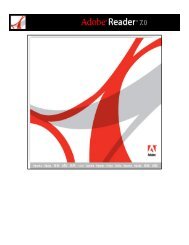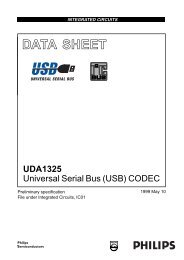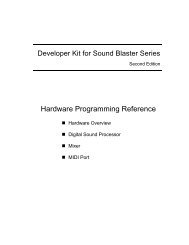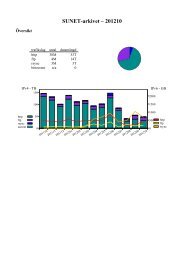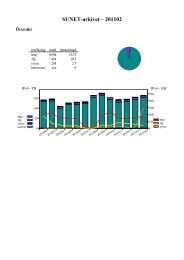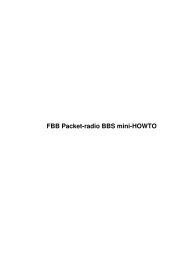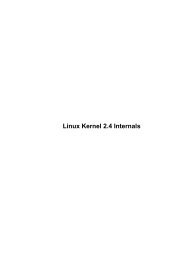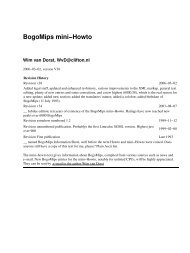Audio Codec '97 Revision 2.1
Audio Codec '97 Revision 2.1
Audio Codec '97 Revision 2.1
Create successful ePaper yourself
Turn your PDF publications into a flip-book with our unique Google optimized e-Paper software.
AC ‘97 Component Specification <strong>Revision</strong> <strong>2.1</strong><br />
The AC-link protocol provides for a special 16-bit 6 time slot (Slot 0) wherein each bit conveys a valid tag for its<br />
corresponding time slot within the current audio frame. A 1 in a given bit position of slot 0 indicates that the<br />
corresponding time slot within the current audio frame has been assigned to a data stream, and contains valid data.<br />
If a slot is tagged invalid, it is the responsibility of the source of the data, (AC ‘97 for the input stream, AC ’97<br />
Controller for the output stream), to stuff all bit positions with 0’s during that slot’s active time.<br />
SYNC remains high for a total duration of 16 BIT_CLKs at the beginning of each audio frame. The portion of the<br />
audio frame where SYNC is high is defined as the Tag Phase. The remainder of the audio frame where SYNC is<br />
low is defined as the “Data Phase”.<br />
Additionally, for power savings, all clock, sync, and data signals can be halted. This requires that AC ‘97 be<br />
implemented as a static design to allow its register contents to remain intact when entering a power savings mode.<br />
5.1.1 AC-link <strong>Audio</strong> Output Frame (SDATA_OUT)<br />
The audio output frame data streams correspond to the multiplexed bundles of all digital output data targeting AC<br />
‘97’s DAC inputs, and control registers. As briefly mentioned earlier, each audio output frame supports up to 12<br />
20-bit outgoing data time slots. Slot 0 is a special reserved time slot containing 16-bits which are used for AC-link<br />
protocol infrastructure.<br />
5.1.1.1 Slot 0: TAG<br />
Within slot 0 the first bit is a global bit (SDATA_OUT slot 0, bit 15) which flags the validity for the entire audio<br />
frame. If the “Valid Frame” bit is a 1, this indicates that the current audio frame contains at least one slot time of<br />
valid data. The next 12 bit positions sampled by AC ‘97 indicate which of the corresponding 12 time slots contain<br />
valid data. In this way data streams of differing sample rates can be transmitted across AC-link at its fixed 48 kHz<br />
audio frame rate 7 .<br />
Figure 11 illustrates the time slot based AC-link protocol. (Please note that Bits 1 and 0 of slot 0 tag phase are now<br />
used for AC ’97 2.x compliant multi-point <strong>Codec</strong> addressing as described in AC ’97 2.0 Appendix C).<br />
SYNC<br />
BIT_CLK<br />
SDATA_OUT<br />
End of previous<br />
<strong>Audio</strong> Frame<br />
Valid<br />
Frame<br />
12.288 MHz<br />
Tag Phase Data Phase<br />
20.8uS<br />
(48 KHz)<br />
81.4 nS<br />
slot(1) slot(2) slot(12) "0" "0" "0"<br />
Time Slot "Valid"<br />
Bits<br />
("1" = time slot contains valid PCM data)<br />
19<br />
29<br />
0 19 0 19 0 19 0<br />
Slot 1 Slot 2<br />
Figure 11. AC-link <strong>Audio</strong> Output Frame<br />
Slot 3 Slot 12<br />
A new audio output frame begins with a low to high transition of SYNC. SYNC is synchronous to the rising edge<br />
of BIT_CLK. On the immediately following falling edge of BIT_CLK, AC ‘97 samples the assertion of SYNC.<br />
This falling edge marks the time when both sides of AC-link are aware of the start of a new audio frame. On the<br />
next rising of BIT_CLK, the AC ’97 Controller transitions SDATA_OUT into the first bit position of slot 0 (Valid<br />
Frame bit). Each new bit position is presented to AC-link on a rising edge of BIT_CLK, and subsequently sampled<br />
by AC ‘97 on the following falling edge of BIT_CLK. This sequence ensures that data transitions, and subsequent<br />
sample points for both incoming and outgoing data streams are time aligned.<br />
6 15-bits defined, with 1 reserved.<br />
7 Control/Status as well as optional extensions of the baseline AC ‘97 specification, such as the modem line <strong>Codec</strong>,<br />
may take advantage of this feature. See AC ’97 2.x Appendices A-D for full description of the standardized<br />
variable rate signaling protocols.<br />
May 22, 1998




